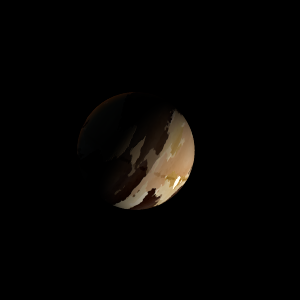|
|
Space Astro
|
Info for exoplanet "Kallegete"
| Scientific (actual) data |
|---|
| Name | Kepler-466 c |
| Planet status | Confirmed |
| Radius | 0.112 |
| Orbital period | 3.70921 |
| Discovered | 2016 |
| Updated | 2021-02-05 |
| Tconj | 2454970 |
| Publication | Announced on a website |
| Detection type | Primary Transit |
| Alternate names | 2MASS J19423569+4829440 c, K00112.02, KIC 10984090 c, KOI-112 c, KOI-112.02, WISE J194235.68+482943.9 c |
| Star name | Kepler-466 |
| Right ascension | 295.65° |
| Declination | 48.5° |
| Mag j | 11.698 |
| Mag h | 11.402 |
| Mag k | 11.367 |
| Star distance | 436 |
| Star metallicity | -0.01 |
| Star mass | 1.04 |
| Star radius | 1.05 |
| Star age | 3.47 |
| Star temperature | 5927 |
| Star alternate names | 2MASS J19423569+4829440, KIC 10984090, KOI-112, WISE J194235.68+482943.9 |
| Wikipedia article | Kepler-466 c |
Back
| |
| Fictional info (?) |
|---|
| Suggested name | Kallegete |
| Planet type | Cold planet |
| It has the longest rotation period (445 days) of any planet in its solar system and rotates in the opposite direction to most other planets.
It is the coldest planetary atmosphere in its solar system, with a minimum temperature of 83°K (-190°C), and has a complex, layered cloud structure with carbon dioxide thought to make up the lowest clouds, and oxygen the uppermost layer of clouds.
The volume of water ice in the south polar ice cap, if melted, would be sufficient to cover the entire planetary surface to a depth of 10 meters.
The largest moon is often known for its large medieval oceanic creatures, the "Jotanda", which feed in the jungle by eating a substance called "Toiakatha Car" if it is available. Most of them are somewhat similar to the Elmecisco, have wings and vary in length from 22 to 45 cm. Jotanda are known to reproduce at temperatures from -10 to 10°C and sometimes predators attacking which is common near the poles. |
| Estimated population | 400 |
| Atmosphere | Oxygen | 61% |
| Carbon dioxide | 24% |
| Methane | 15% |
| Water | 0.034% |
| Atmospheric pressure | 0.8 bar |
 |
| Moon | Mirron Tis | Huge irregular oceanic moon |
| Google search for Kallegete |
|
Website by Joachim Michaelis
|
|
|
|